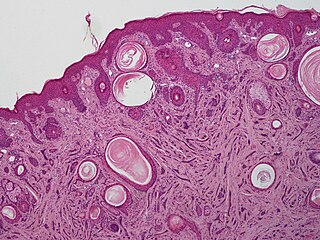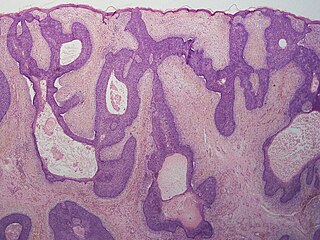
The integumentary system comprises the skin and its appendages acting to protect the body from various kinds of damage, such as loss of water or damages from outside. The integumentary system includes hair, scales, feathers, hooves, and nails. It has a variety of additional functions; it may serve to waterproof, and protect the deeper tissues, excrete wastes, and regulate body temperature, and is the attachment site for sensory receptors to detect pain, sensation, pressure, and temperature. In most land vertebrates with significant exposure to sunlight, the integumentary system also provides for vitamin D synthesis.

A basidiospore is a reproductive spore produced by Basidiomycete fungi, a grouping that includes mushrooms, shelf fungi, rusts, and smuts. Basidiospores typically each contain one haploid nucleus that is the product of meiosis, and they are produced by specialized fungal cells called basidia. Typically, four basidiospores develop on appendages from each basidium, out of these 2 are of one strain and other 2 of its opposite strain. In gills under a cap of one common species, there exist millions of basidia. Some gilled mushrooms in the order Agaricales have the ability to release billions of spores. The puffball fungus Calvatia gigantea has been calculated to produce about five trillion basidiospores. Most basidiospores are forcibly discharged, and are thus considered ballistospores. These spores serve as the main air dispersal units for the fungi. The spores are released during periods of high humidity and generally have a night-time or pre-dawn peak concentration in the atmosphere.
In anatomy, adnexa refers to the appendages of an organ. The term adnexa stems from a Latin word meaning appendages.

Necrobiosis lipoidica is a necrotising skin condition that usually occurs in patients with diabetes mellitus but can also be associated with rheumatoid arthritis. In the former case it may be called necrobiosis lipoidica diabeticorum (NLD). NLD occurs in approximately 0.3% of the diabetic population, with the majority of sufferers being women.

Hidradenoma refers to a benign adnexal tumor of the apical sweat gland. These are 1–3 cm translucent blue cystic nodules. It usually presents as a single, small skin-colored lesion, and is considered distinct from the closely related poroma. Hidradenomas are often sub-classified based on subtle histologic differences, for example:

ISDN is a music album by experimental electronica artists The Future Sound of London which was released in two different versions in 1994 and 1995. The music on the album is edited together from various live broadcasts that the band had broadcast to radio stations all over the world using ISDN, which at the time was a relatively new technology. The band repeated the format in 1997 with the limited edition ISDN Show, another live album of ISDN broadcasts.

The uterine appendages are the structures most closely related structurally and functionally to the uterus.
Congenital cystic eye is an extremely rare ocular malformation where the eye fails to develop correctly in utero and is replaced by benign, fluid-filled tissue. Its incidence is unknown, due to the very small number of cases reported. An audit by Duke-Elder of the medical literature from 1880 to 1963 discovered only 28 cases. The term was coined in 1937 by the renowned ophthalmologist Ida Mann.
Skin appendages are skin-associated structures that serve a particular function including sensation, contractility, lubrication and heat loss. In humans, some of the more common skin appendages are hairs, arrector pilli, sebaceous glands, sweat glands, and nails (protection).
An adnexal mass is a lump in tissue of the adnexa of uterus. Adnexal masses can be benign or cancerous, and they can be categorized as simple or complex. One of the most important factors used to determine the clinical suspicion of malignancy of an adnexal mass is the sonographic appearance of the mass. Indications that the mass is at a higher risk of being malignant include the presence of loculations, nodules, papillary structures, or septations or a size greater than 10 cm.

In dermatologic pathology, a dermal cylindroma, also dermal eccrine cylindroma or Cutaneous Cylindroma) and cylindroma, is a benign adnexal tumor, which occurs on the scalp and forehead.when multiple Cylindroma-Show Hat like configuration.

Mucinous carcinoma is a type of cancer that arises from epithelial cells; these line certain internal organs and skin, and produce mucin.

Warty dyskeratoma, also known as an Isolated dyskeratosis follicularis, is a benign epidermal proliferation with distinctive histologic findings that may mimic invasive squamous cell carcinoma and commonly manifests as an umbilicated lesion with a keratotic plug, WD have some histopathologic similarities to viral warts but it's not caused by HPV and the majority of these lesions display overall histopathologic features consistent with a follicular adnexal neoplasm. usually limited to the head, neck, scalp or face and vulva. Lesions are generally solitary and sporadic and may be associated with a follicular unit. Oral involvement, particularly the hard palate, and genital involvement have been reported. it can also be thought of as one of the manifestations of focal acantholytic dyskeratosis, an epidermal reaction pattern that can be seen in several disorders, including Darier's disease and Grover's disease. But the main Difference between Darier disease and Warty dyskeratoma, is that Darier disease inherited dermatosis consisting of multiple keratotic papules on the face, trunk, and extremities, while WD occurs as an isolated, noninherited, single keratotic nodule mainly confined to the head and neck as mentioned earlier.

A Corpus luteum cyst is a type of ovarian cyst which may rupture about the time of menstruation, and take up to three months to disappear entirely. A corpus luteum cyst rarely occurs in women over the age of 50, because eggs are no longer being released after menopause. Corpus luteum cysts may contain blood and other fluids. The physical shape of a corpus luteum cyst may appear as an enlargement of the ovary itself, rather than a distinct mass -like growth on the surface of the ovary.

A poroma is a benign skin tumor derived from sweat glands. Although the original term poroma was initially used to describe a tumor derived from the ductal epithelium of eccrine sweat glands, the term is used in general reference to tumors derived from ductal portions of both eccrine and apocrine sweat glands. Specific sub-types are primarily defined by location of tumor, and include:

Microcystic adnexal carcinoma (MAC) is a rare sweat gland cancer, which often appears as a yellow spot or bump in the skin. It usually occurs in the neck or head, although cases have been documented in other areas of the body. Most diagnosis occur past the age of 50. Although considered an invasive cancer, metastasis rarely occurs. Main treatments are wide local excision or Mohs micrographic surgery, which ensures that most, if not all, cancer cells are removed surgically.

Eccrine carcinoma is a rare skin condition characterized by a plaque or nodule on the scalp, trunk, or extremities. It originates from the eccrine sweat glands of the skin, accounting for less than 0.01% of diagnosed cutaneous malignancies. Eccrine carcinoma tumors are locally aggressive with a high rate of recurrence. Lack of reliable immunohistochemical markers and similarity to other common tumors has made identification of eccrine carcinoma difficult.

A basaloid follicular hamartoma is a cutaneous condition characterized as distinctive benign adnexal tumor that has several described variants.

Adnexa are the accessory structures which are involved in protecting and/or supporting the function of an organ. Accessory visual structures are the adnexa of the eye, including the eyebrow, eyelids, and lacrimal apparatus. The eyebrows, Eyelids, Eye lashes, Lacrimal gland and drainage apparatus all plays a crucial role with regards to globe protection, lubrication, and minimizing the risk of ocular infection. The adnexal structures also help to keep cornea moist and clean.
Oculocerebrocutaneous syndrome is a condition characterized by orbital cysts, microphthalmia, porencephaly, agenesis of the corpus callosum, and facial skin tags.













